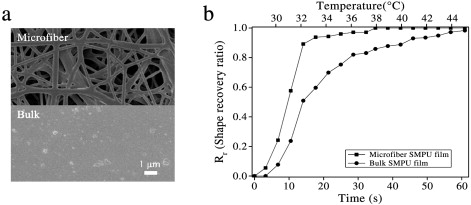 单篇全文显示
单篇全文显示
1. Jingnan Zhang, Yongmei Ma, Jingjing Zhang, Dan Xu, Qinglin Yang, Jianguo Guan, Xinyu Cao, Lei Jiang, Microfiber SMPU film affords quicker shape recovery than the bulk one. Materials Letters, 2011, 65, 3639-3642.
Abstract:
Comparing to the bulk SMPU (shape memory polyurethane) film, microfiber SMPU film afforded much quicker and sharper shape recovery when heated in water bath. The shape recovery of the microfiber film only took ~ 1/4 time of that needed for the bulk film from Rr (shape recovery ratio) = 10% to Rr = 90%. The final Rr and Rf (shape fix ratio) of the microfiber film was also enhanced. The microfiber film was fabricated by electrospinning with the fiber diameter of 200 nm to 1 μm. DSC and DMA results indicate that the formation of microfiber has very limited effect on the Ttrans (switching temperature) of the SMPU. The quick shape recovery of the microfiber SMPU film is considered due to the higher surface area of microfiber film that is favorable for quicker heating/cooling of the sample and quicker diffusion of water. This study offers a possible way to improve the shape recovery speed without changing the chemical composition, which may meet special needs for sensors or actuators of biomedical devices and others.
2. Lili Zhang, Ru Bai, Bai Li, Cuicui Ge, Jiangfeng Du, Ying Liu, Laurent Le Guyader, Yuliang Zhao, Yanchuan Wu, Shida He, Yongmei Ma, Chunying Chen, Rutile TiO(2) particles exert size and surface coating dependent retention and lesions on the murine brain (1). Toxicology Letters, 2011, 207, 73-81.
Abstract:
The rising commercial use and large-scale production of engineered nanoparticles (NPs) may lead to unintended exposure to humans. The central nervous system (CNS) is a potential susceptible target of the inhaled NPs, but so far the amount of studies on this aspect is limited. Here, we focus on the potential neurological lesion in the brain induced by the intranasally instilled titanium dioxide (TiO2) particles in rutile phase and of various sizes and surface coatings. Female mice were intranasally instilled with four different types of TiO2 particles (i.e. two types of hydrophobic particles in micro- and nano-sized without coating and two types of water-soluble hydrophilic nano-sized particles with silica surface coating) every other day for 30 days. Inductively coupled plasma mass spectrometry (ICP-MS) were used to determine the titanium contents in the sub-brain regions. Then, the pathological examination of brain tissues and measurements of the monoamine neurotransmitter levels in the sub-brain regions were performed. We found significant up-regulation of Ti contents in the cerebral cortex and striatum after intranasal instillation of hydrophilic TiO2 NPs. Moreover, TiO2 NPs exposure, in particular the hydrophilic NPs, caused obvious morphological changes of neurons in the cerebral cortex and significant disturbance of the monoamine neurotransmitter levels in the sub-brain regions studied. Thus, our results indicate that the surface modification of the NPs plays an important role on their effects on the brain. In addition, the difference in neurotoxicity of the two types of hydrophilic NPs may be induced by the shape differences of the materials. The present results suggest that physicochemical properties like size, shape and surface modification of the nanomaterials should be considered when evaluating their neurological effects.
3. Shuai Zhang, Xinyu Cao, Yongmei Ma, Yucai Ke, Jingkun Zhang, Fosong Wang, The effects of particle size and content on the thermal conductivity and mechanical properties of Al(2)O(3)/high density polyethylene (HDPE) composites. Express Polymer Letters, 2011, 5, 581-590.
Abstract:
The influences of filler size and content on the properties (thermal conductivity, impact strength and tensile strength) of Al2O3/high density polyethylene (HDPE) composites are studied. Thermal conductivity and tensile strength of the composites increase with the decrease of particle size. The dependence of impact strength on the particle size is more complicated. The SEM micrographs of the fracture surface show that Al2O3 with small particle size is generally more efficient for the enhancement of the impact strength, while the 100 nm particles prone to aggregation due to their high surface energy deteriorate the impact strength. Composite filled with Al2O3 of 0.5 μm at content of 25 vol% show the best synthetic properties. It is suggested that the addition of nano-Al2O3 to HDPE would lead to good performance once suitably dispersed.
4. Shuai Zhang, Xinyu Cao, Yongmei Ma, Fabrication of alumina ribbons with mixed solvent system in electrospinning. Journal of Optoelectronics and Advanced Materials, 2011, 13, 425-427.
Abstract:
Alumina ribbons were fabricated facilely via using mixed solvent of ethanol and ethyl ether in electrospinning, and α-alumina ribbons were obtained after the as prepared ribbons were calcinated at 1200 oC for 1 h. The as prepared ribbons are composed of dense skin and porous inner structure, the thickness and width of which are of 1 μm and 3-5 μm respectively. After calcination, the corresponding sizes of the ribbons shrunk to ~ 200 nm and 2-3 μm separately. If solo solvent (ethanol) was used in the electrospinning experiment, only round alumina fibers were obtained.
